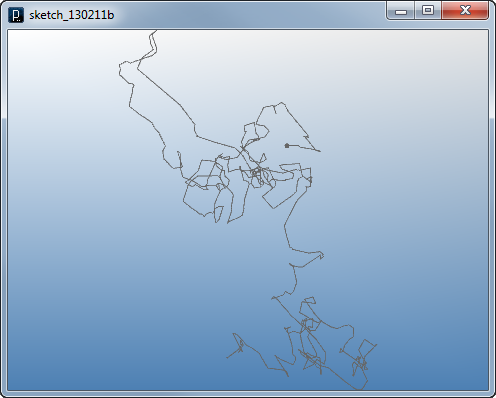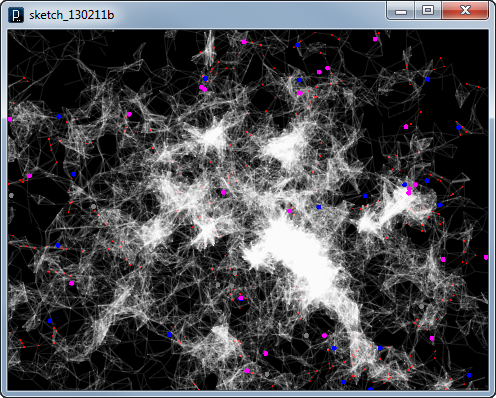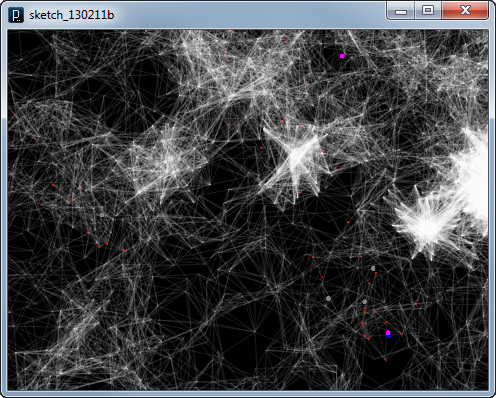

 Python Tutorials Python Tutorials | (back to the list of tutorials) |
 Particle Based Agent
Particle Based Agent![]()
![]()
![]()
![]()
add_library('igeo')
def setup() :
size(480,360,IG.GL)
MyParticle(IVec(0,0,0), IVec(10,0,0))
class MyParticle(IParticle) :
def __init__(self, p, v) :
IParticle.__init__(self,p,v) # initialize with position and velocity
The code above shows just one moving particle. If you want to show a trajectory of a particle, you can use IParticleTrajectory instead of IParticle.
![]()
![]()
![]()
![]()
add_library('igeo')
def setup() :
size(480,360,IG.GL)
MyParticle(IVec(0,0,0), IVec(10,0,0))
class MyParticle(IParticleTrajectory) :
def __init__(self, p, v) :
IParticleTrajectory.__init__(self,p,v) # initialize with position and velocity

 Random Walk Rule in Update Method
Random Walk Rule in Update Method![]()
![]()
![]()
![]()
add_library('igeo')
def setup() :
size(480,360,IG.GL)
MyParticle(IVec(0,0,0), IVec(10,0,0))
class MyParticle(IParticleTrajectory) :
def __init__(self, p, v) :
IParticleTrajectory.__init__(self,p,v) # initialize with position and velocity
self.fric(0.05) # 5% friction
def update(self) :
if IRand.pct(10) :
self.push(IRand.pt(-1000,-1000,0,1000,1000,0))

 Attraction Force Rule in Interact Method
Attraction Force Rule in Interact Method![]()
![]()
![]()
![]()
add_library('igeo')
def setup() :
size(480,360,IG.GL)
for i in range(50) :
MyParticle(IRand.pt(-50,-50,0,50,50,0), IVec(0,0,0))
class MyParticle(IParticleTrajectory) :
def __init__(self, p, v) :
IParticleTrajectory.__init__(self,p,v) # initialize with position and velocity
self.fric(0.05) # 5% friction
def interact(self, agents) :
for agent in agents :
if isinstance(agent, MyParticle) :
if agent is not self :
if agent.pos().dist(self.pos()) < 15 : # closer than 15
dif = self.pos().dif(agent.pos()) #other to this
dif.len(40) # intensity of force
agent.push(dif)
def update(self) :
if IRand.pct(10) :
self.push(IRand.pt(-500,-500,0,500,500,0))

 Adding A State Property
Adding A State Property![]()
![]()
![]()
![]()
add_library('igeo')
def setup() :
size(480,360,IG.GL)
for i in range(100) :
MyParticle(IRand.pt(-50,-50,0,50,50,0), IVec(0,0,0))
class MyParticle(IParticleTrajectory) :
def __init__(self, p, v) :
IParticleTrajectory.__init__(self,p,v) # initialize with position and velocity
self.fric(0.05) # 5% friction
self.state = 0 # initial state
def interact(self, agents) :
for agent in agents :
if isinstance(agent, MyParticle) :
if agent is not self :
if agent.pos().dist(self.pos()) < 15 : # closer than 15
dif = self.pos().dif(agent.pos())#other to this
dif.len(40) # intensity of force
if self.state == 1 : # attraction
agent.push(dif)
elif self.state == 2 : # repulsion
agent.pull(dif)
def update(self) :
if IRand.pct(10) :
self.push(IRand.pt(-500,-500,0,500,500,0))
if IRand.pct(1) : # switch state
if self.state == 0 : # state 0 -> 1
self.state = 1 # attraction
self.clr(1.0,0,1.0)
elif self.state == 1 : # state 1 -> 2
self.state = 2 # repulsion
self.clr(0,0,1.0)
else : # state 2 -> 0
self.state = 0 # random walk only
self.clr(0.5)

 Other Agent Classes to Interact
Other Agent Classes to Interact![]()
![]()
![]()
![]()
add_library('igeo')
def setup() :
size(480,360,IG.GL)
for i in range(100) :
MyParticle(IRand.pt(-50,-50,0,50,50,0), IVec(0,0,0))
IG.bg(0)
class MyParticle(IParticle) :
def __init__(self, p, v) :
IParticle.__init__(self,p,v) # initialize with position and velocity
self.fric(0.05) # 5% friction
self.state = 0 # initial state
def interact(self, agents) :
for agent in agents :
if isinstance(agent, MyParticle) :
if agent is not self :
if agent.pos().dist(self.pos()) < 15 : # closer than 15
dif = self.pos().dif(agent.pos())#other to this
dif.len(20) # intensity of force
if self.state == 1 : # attraction
agent.push(dif)
elif self.state == 2 : # repulsion
agent.pull(dif)
def update(self) :
if IRand.pct(10) :
self.push(IRand.pt(-500,-500,0,500,500,0))
if IRand.pct(1) : # switch state
if self.state == 0 : # state 0 -> 1
self.state = 1 # attraction
self.clr(1.0,0,1.0)
elif self.state == 1 : # state 1 -> 2
self.state = 2 # repulsion
self.clr(0,0,1.0)
else : # state 2 -> 0
self.state = 0 # random walk only
self.clr(0.5)
if self.time()%20 == 0 :
Anchor(self.pos().cp())
class Anchor(IAgent) :
def __init__(self, p) :
self.pos = p
self.point = IPoint(self.pos).clr(1.0,0,0).size(2)
def interact(self, agents) :
if self.time() == 0 : # only when the first time
for agent in agents :
if isinstance(agent, Anchor) :
if agent is not self and agent.time() > 0 : # exclude anchors just created
if agent.pos.dist(self.pos) < 10 : # closer than 10
ICurve(agent.pos, self.pos).clr(1.0,0.1)
def update(self) :
if self.time()==100 : # delete after 100 time frame
self.point.del()
self.del()


 HOME
HOME
 FOR PROCESSING
FOR PROCESSING
 DOWNLOAD
DOWNLOAD
 DOCUMENTS
DOCUMENTS
 TUTORIALS (Java /
Python)
TUTORIALS (Java /
Python)
 GALLERY
GALLERY
 SOURCE CODE(GitHub)
SOURCE CODE(GitHub)
 PRIVACY POLICY
PRIVACY POLICY
 ABOUT/CONTACT
ABOUT/CONTACT
